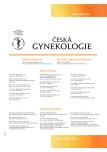Complete hydatidiform mole in perimenopausal patient imitating uterine cancer
Authors:
Petra Bretová 1; Luděk Kostka 2; J. Hausnerová 3; Vít Weinberger 1
Authors‘ workplace:
Gynekologicko‑porodnická klinika LF MU a FN, Brno, přednosta doc. MUDr. V. Weinberger, Ph. D.
1; Lékařská fakulta Masarykovy univerzity, Brno, rektor prof. MUDr. M. Repko, Ph. D.
2; Ústav patologie FN Brno a LF MU, přednosta doc. MUDr. L. Křen, Ph. D.
3
Published in:
Ceska Gynekol 2020; 85(5): 314-318
Category:
Case Report
Overview
Case report of a perimenopausal patient with
histologically confirmed molar pregnancy, which was
imitating a malignant tumor of the uterus according to
an ultrasound examination.
Design: Case report.
Setting: Department of Obstetrics and Gynecology,
Masaryk University, University Hospital Brno.
Case report: The 51-year-old patient went to the gynecological
clinic for a month of spotting. A large tumor
was described during the ultrasound examination. It was
without an obvious invasion of the myometrium, but
significantly oppressing it. Dilatation and curettage were
indicated, which brought a surprising result – complete
hydatidiform mole. The patient wished to preserve the
uterus, so the treatment was completed by vacuum
aspiration and curettage of the uterus under ultrasound
control to remove all the rest material. The patient was
monitored at regular intervals until β-hCG negativity.
Currently, there are no signs of disease recurrence three
years after the procedure.
Conclusion: Gestational trophoblastic disease is relatively
rare in women in the peri- and postmenopausal
period, however, it is advisable to keep this diagnosis in
mind and complete β-hCG examination in the case of a
suspicious ultrasound image. Hysterectomy dominates
as the treatment method even in benign forms of the
disease. A vacuum aspiration/curettage of the uterus
with subsequent careful follow up can be alternative
option.
Keywords:
complete hydatidiform mole – gestational trophoblastic disease – perimenopausal bleeding
Sources
1. Benson, CB., Genest, DR., Bernstein, MR., et al. Sonographic appearance of first trimester complete hydatidiform moles. Ultrasound Obstet Gynecol, 2000, 16(2), p. 188–191.
2. Ghassemzadeh, S., Kang, M. Hydatidiform mole. In: StatPearls. Treasure Island (FL): StatPearls Publishing; June 29, 2020.
3. Golfier, F., Clerc, J., Hajri, T., et al. Contribution of referent pathologists to the quality of trophoblastic diseases diagnosis. Hum Reprod, 2011, 26(10), p. 2651–2657.
4. Heller, DS. Update on the pathology of gestational trophoblastic disease. APMIS, 2018, 126(7), p. 647–654.
5. Heřman, J., Rob, L., Robová, H., et al. Molární těhotenství z pohledu patologa a klinika. Čes Gynek, 2019, 84(6), s. 418–424.
6. Kubelka-Sabit, KB., Prodanova, I., Jasar, D., et al. Molecular and immunohistochemical characteristics of complete hydatidiform moles. Balkan J Med Genet, 2017, 20(1), p. 27–34.
7. Lurain, JR. Gestational trophoblastic disease I: epidemiology, pathology, clinical presentation and diagnosis of gestational trophoblastic disease, and management of hydatidiform mole. Am J Obstet Gynecol, 2010, 203(6), p. 531–539.
8. Lurain, JR. Gestational trophoblastic disease II: classification and management of gestational trophoblastic neoplasia. Am J Obstet Gynecol, 2011, 204(1), p. 11–18.
9. Mehrotra, S., Singh, U., Chauhan, S. Molar pregnancy in postmenopausal women: a rare phenomenon. BMJ Case Reports, 2012, 2012, bcr2012006213.
10. Ngan, HYS., Seckl, MJ., Berkowitz, RS., et al. Update on the diagnosis and management of gestational trophoblastic disease. Int J Gynaecol Obstet, 2018, 143, Suppl 2, p. 79–85.
11. Santaballa, A., García, Y., Herrero, A., et al. SEOM clinical guidelines in gestational trophoblastic disease (2017). Clin Transl Oncol, 2018, 20(1), p. 38–46.
12. Seckl, MJ., Sebire, NJ., Berkowitz, RS. Gestational trophoblastic disease. Lancet, 2010, 376(9742), p. 717–729.
13. Shaaban, AM., Rezvani, M., Haroun, RR., et al. Gestational trophoblastic disease: clinical and imaging features. Radiographics, 2017, 37(2), p. 681–700.
14. Tsukamoto, N., Iwasaka, T., Kashimura, Y., et al. Gestational trophoblastic disease in women aged 50 or more. Gynecol Oncol, 1985, 20(1), p. 53–61.
15. Yuk, JS., Baek, JC., Park, JE., et al. Incidence of gestational trophoblastic disease in South Korea: a longitudinal, population-based study. Peer J, 2019, 7, p. e6490.
Labels
Paediatric gynaecology Gynaecology and obstetrics Reproduction medicineArticle was published in
Czech Gynaecology

2020 Issue 5
Most read in this issue
- Clinical significance of routine ultrasound screening of fetal growth restriction in third trimester of pregnancy
- Bilateral salpigektomy as a sterilization method – ovarian cancer prevetion and a rare complication
- Complete hydatidiform mole in perimenopausal patient imitating uterine cancer
- Cervical mucus and its role in reproduction
